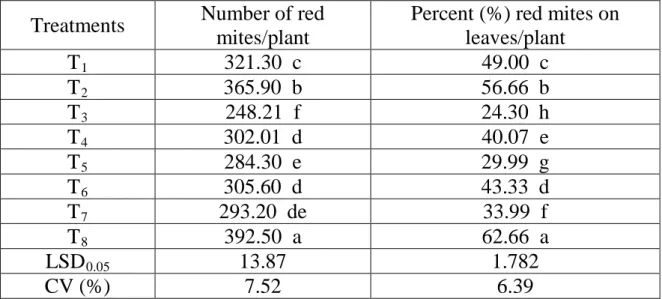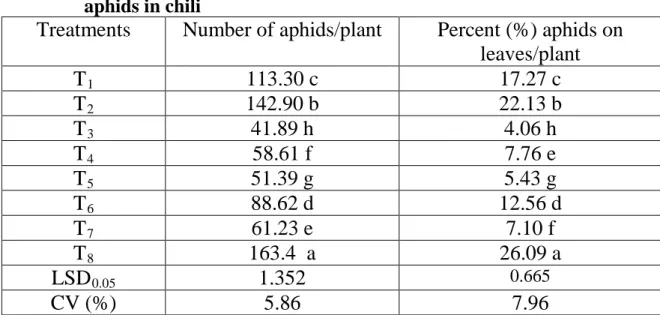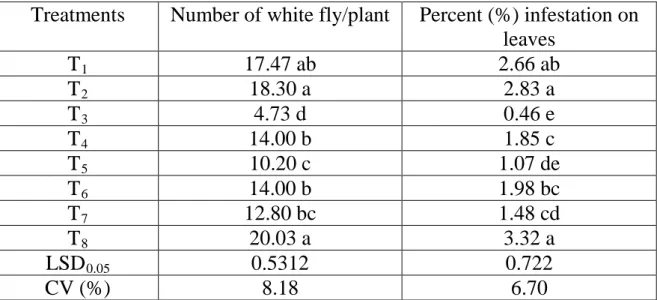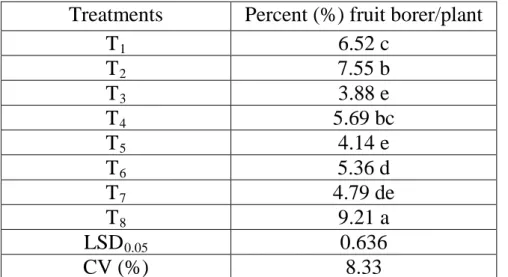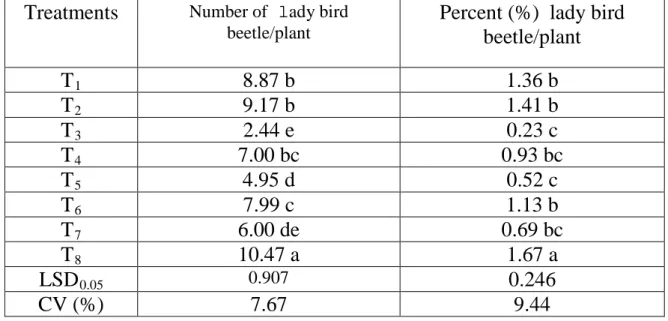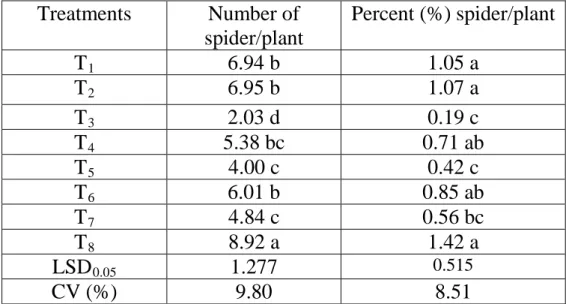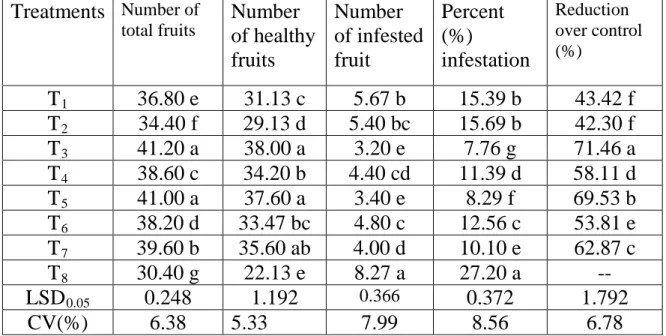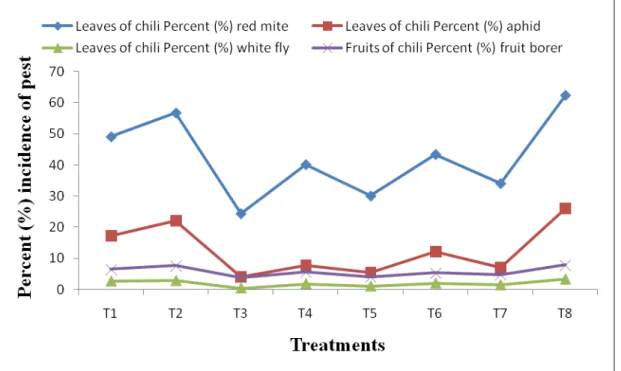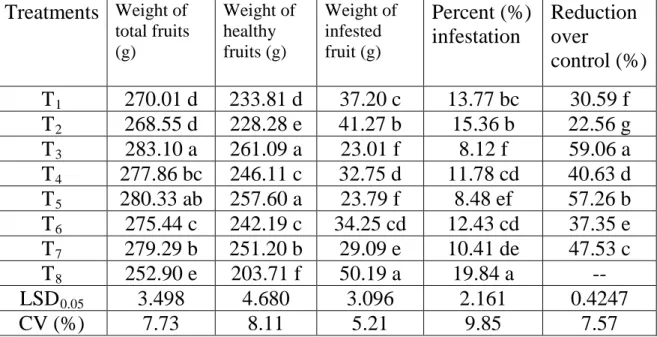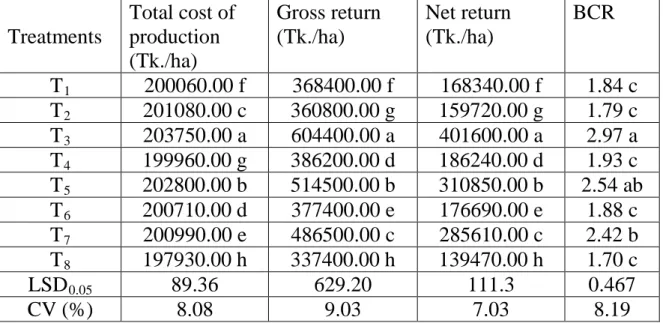70
STUDY ON THE EFFICACY OF BOTANICALS AND SOME SELECTED PESTICIDES ON PEST
COMPLEX OF CHILI (Capsicum frutescens)
BY
MD. BADAL MALLIK
DEPARTMENT OF ENTOMOLOGY
SHER-E-BANGLA AGRICULTURAL UNIVERSITY DHAKA -1207
DECEMBER, 2008
71
STUDY ON THE EFFICACY OF BOTANICALS AND SOME SELECTED PESTICIDES ON PEST
COMPLEX OF CHILI (Capsicum frutescens)
BY
MD. BADAL MALLIK
REGISTRATION NO. 07-02607
A Thesis
Submitted to the Faculty of Agriculture Sher-e-Bangla Agricultural University, Dhaka,
in partial fulfilment of the requirements for the degree of
MASTER OF SCIENCE IN
ENTOMOLOGY
SEMESTER: JULY-DECEMBER, 2008
Approved by:
………..
(Dr. Md. Mizanur Rahman) Associate professor
Department of Entomology
&
Research Supervisor
………
(Jahanara Begum) Professor
Department of Entomology &
Co-Supervisor
………
Dr. Md. Abdul Latif Associate Professor
&
Chairman
Department of Entomology
Sher-e-Bangla Agricultural University, Dhaka -1207
72
DEPARTMENT OF ENTOMOLOGY Sher-e-Bangla Agricultural University
Sher-e-Bangla Nagar, Dhaka-1207 Bangladesh
PABX: +88029144270-9 Ext. 309 (Off.) 206 (Res.) Fax: +88029112649 e-mail: [email protected]
Ref: Date: ---
CERTIFICATE
This is to certify that the thesis entitled, “Study on the Efficacy of Botanicals
and Some Selected Pesticides on Pest Complex of Chili (Capsicum frutescens)”submitted to the Department of Entomology, Faculty of Agriculture,Sher-e-Bangla Agricultural University, Dhaka in partial fulfilment of the requirements for the degree of MASTER OF SCIENCE in ENTOMOLOGY embodies the result of a piece of bonafide research work carried out by Md.
Badal Mallik , Registration No. 02607 under my supervision and guidance.
No part of the thesis has been submitted for any other degree or diploma.
I further certify that such help or source of information, as has been availed of during the course of this investigation has been duly acknowledged by him.
---
(Dr. Md. Mizanur Rahman) Associate Professor
Dated: Department of Entomology Dhaka, Bangladesh SAU, Dhaka
&
Research Supervisor
73
Dedicated to My
Departed Father
74
ACKNOWLEDGEMENTS
All praises are due to the Almighty “Allah” Who kindly enabled the author successfully to complete M.S degree.
The author feels proud to express his profound respect, deepest sense of gratitude, heartfelt appreciation to his research supervisor Dr. Md. Mizanur Rahman, Associate professor, Department of Entomology, Sher-e-Bangla Agricultural University, Dhaka for his constant inspiration, scholastic guidance and invaluable suggestions during the conduct of the research and for his constructive criticism and whole hearted co- operation during preparation of this thesis.
The author express his heartfelt gratitude and indebtness also to his honorable Co- supervisor Jahanara Begum, Professor, Department of Entomology, Sher-e-Bangla Agricultural University, Dhaka for his assistance in planning and execution of the study and for his constructive instruction, critical reviews and heartiest co-operation during preparation of the manuscript.
The author also expresses his heartfelt thanks to all the teachers of the Department of Entomology, Sher-e-Bangla Agricultural University, Dhaka for their help, valuable suggestions and encouragement during the period of study.
The Author is also wish to acknowledge his indebtedness to the Entomology Farm Division of Sher-e-Bangla Agricultural University and Bangladesh Jute Research Institute, Dhaka.
The author also expresses his heartiest felicitation to Enam, Santosh, Mukul, Jakir, Azim, Anjan, Asad , Tofayel , Bashir, Munna and Zahid for their continuous co- operation.
At last but not the least, the Author feel indebtedness to be beloved parents and relatives, whose sacrifice, inspiration, encouragement and continuous blessing paved the way to is higher education.
The Author
75
CONTENTS
Chapter Title Page
ACKNOWLEDGEMENTS iv
ABSTRACT v
LIST OF CONTENTS vi-ix
LIST OF TABLES x
LIST OF FIGURES xi
LIST OF PLATES xi
LIST OF APPENDICES xii
1 INTRODUCTION 1-3
2 REVIEW OF LITERATURE 4-17
2.1 Effect of chemicals for controlling pest 4
2.2 Effect of botanicals for controlling pest 6
2.2.1 Effect of plant extracts for controlling mite pest 6 2.2.2 Effect of plant extracts for controlling other pests 9
3 MATERIALS AND METHODS 18-27
3.1 General conditions 18
3.1.1 Geographical location 18
3.1.2 Agro-ecological region 18
3.1.3 Climate 18
3.2 Characteristics of soil 19
3.3 Planting materials 19
3.4 Treatments of the experiment 19
3.5 Collection of botanicals and its extraction mechanism 20
3.5.1 Preparation of garlic clove extract 20
3.5.2 Preparation of Biskatali leaf extract 20
3.5.3 Preparation of neem leaf extract 20
3.5.4 Preparation of neem seed or kernel extract 20
3.5.5 Preparation of neem oil 20
3.6 Collection of chemical pesticides 21
3.7 Design and layout of the experiment 24
3.8 Preparation of the main field 24
3.9 Application of manure and fertilizers 25
76
vi
CONTENTS (Contd.)
Chapter Title Page
3.10 Intercultural operations and irrigations 25
3.11 Data collection 25
A Field data 25-26
a Number of branch per plant b Number of leaf per branch
c Number of infested leaves per branch d Number of infested leaves per plant e Number of healthy leaf per branch f Number of insects per leaves g Number of predators per plant h Number of fruits per branch
i Number of infested fruit per branch j Weight of healthy fruit per plant k Total weight of fruit per plot
B Calculated data 26
a Infestation with pest complex 27
3.12 Yield of chili 27
3.12.1 Yield per plot 3.12.2 Yield per hectare 3.12.3 Benefit cost ratio
3.13 Statistical analysis 27
4 RESULTS AND DISCUSSION 28-57
4.1 Effect of different treatments on mite 28
4.1.1 Number of red mite per plant 28
4.1.2 Percent red mite per plant 28
4.2 Effect of different treatments on aphid 30
4.2.1 Number of aphid per plant 30
77 vii
CONTENTS (Contd.)
Chapter Title Page
4.2.2 Percent aphid per plant 30
4.3 Effect of different treatments on white fly 32
4.3.1 Number of white fly per plant 32
4.3.2 Percent white fly per plant 32
4.4 Effect of different treatments on fruit borer 33
4.4.1 Percent fruit borer per plant 33
4.5 Effect of different treatments on lady bird beetle 35
4.5.1 Number of lady bird beetle per plant 35
4.5.2 Percent lady bird beetle per plant 35
4.6 Effect of different treatments on spider 36
4.6.1 Number spider per plant 36
4.6.2 Percent spider per plant 37
4.7 Effect of different treatments on leaves against pest complex of chili
38
4.7.1 Number of total leaves per plant 38
4.7.2 Number of healthy leaves 38
4.7.3 Number of infested leaves 40
4.7.4 Percent infestation 41
4.7.5 Percent reduction over control 41
4.8 Effect of different treatments on fruits against pest complex of chili
42
4.8.1 Number of total fruits per plant 42
4.8.2 Number of healthy fruits 44
4.8.3 Number of infested fruits 44
4.8.4 Percent infestation 45
4.8.5 Percent reduction over control 45
78 viii
CONTENTS (Contd.)
Chapter Title Page
4.9 Comparative effectiveness of treatments on leaves of chili 46
4.9.1 Percent red mite per plant 46
4.9.2 Percent aphid per plant 47
4.9.3 Percent white fly per plant 47
4.10 Comparative effectiveness of treatments on fruits of chili 48
4.10.1 Percent fruit borer per plant 48
4.11 Effect of treatments on yield against pest complex of chili 49
4.11.1 Weight of total fruits per plant (g) 49
4.11.2 Weight of healthy fruits per plant (g) 50 4.11.3 Weight of infested fruits per plant (g) 50
4.11.4 Percent infestation of fruits 51
4.11.5 Percent reduction over control 51
4.12 Yield performance 52
4.12.1 Yield (kg/plot) 52
4.12.2 Yield (t/ha) 53
4.12.3 Percent increase over control 53
4.13 Economic analysis 54
4.13.1 Total cost of production (Tk./ha) 55
4.13.2 Gross return (TK./ha) 55
4.13.3 Net return (TK./ha) 55
4.13.4 Benefit cost ratio (BCR) 56
5 SUMMARY AND CONCLUSION 58-60
6 REFERENCES 61-69
7 APPENDICES 70-77
79
ix LIST OF TABLES
Number Title Page
01 Effects of botanicals and chemical pesticides on the incidence of red mite in chili
29 02 Effects of botanicals and chemical pesticides on the
incidence of aphids in chili
31 03 Effects of botanicals and chemical pesticides on the
incidence of white fly in chili
33 04 Effects of botanicals and chemical pesticides on the
incidence of fruit borer in chili
34 05 Effects of botanicals and chemical pesticides on the
incidence of natural enemies (Lady Bird Beetle) in chili
36
06 Effects of botanicals and chemical pesticides on the incidence of natural enemies (spider/plant) in chili
37 07 Effects of botanicals and chemical pesticides against
pest complex of chili during the total cropping season by number/plant
42
08 Effects of botanicals and chemical pesticides against chili fruit borer by number per plant during the total cropping season
46
09 Effects of botanicals and chemical pesticides against chili fruit borer in weight per plant during the total cropping season
52
10 Effects of botanicals and chemical pesticides on economic analysis of chili production during the total cropping Season
57
80 x
LIST OF FIGURES
Number Title Page
01 Comparative effect of botanicals and chemical pesticides on the incidence of pest complex of chili in percentage
49
02 Effects of botanicals and chemical pesticides on yield of chili during the total cropping season
54
LIST OF PLATES
Plate No. Title Page
1 Garlic clove extract 21
2 Biskatali leaf extract 21
3 A. Fresh neem leaf 22
B. Neem leaf extract 22
4 A. Neem seed kernel extract 23
B. Neem seed kernel 23
5 Neem oil 24
6 A. Chemical pesticides treated chili plot 39 B. Botanicals treated chili plants 39
7 A. Pest infested chili leaves 40
B. Pest infested chili twig 40
8 A. Healthy green chili fruit 43
B. Healthy ripen chili fruit 43
9 A. Larva of chili fruit borer on chili 44 B. Chili fruit borer infested fruit in plant 44
81 xi
LISTS OF APPENDICES
82 xii
Number Title Page
I Map showing the experimental site under the study 70 II Monthly average of air temperature, relative humidity and
total rainfall of the experimental site during the period from January 2008 to September 2008
71
III Physical characteristics and chemical composition of soil of the experimental plot.
72 IV Analysis of variance on data with the effects of botanicals
and chemical pesticides against pest complex of chili
72 V Analysis of variance on data with the effects of botanicals
and chemical pesticides against pest complex of chili
73 VI Analysis of variance on data with the effects of botanicals
and chemical pesticides against pest complex of chili
73 VII Analysis of variance on data with the effects of botanicals
and chemical pesticides against pest complex of chili
73 VIII Analysis of variance on data with the effects of botanicals
and chemical pesticides against pest complex of chili
74 IX Analysis of variance on data with the effects of botanicals
and chemical pesticides against pest complex of chili
74 X Analysis of variance on data with the effects of botanicals
and chemical pesticides against pest complex of chili
74 XI Analysis of variance on data with the effects of botanicals
and chemical pesticides against pest complex of chili
75 XII Analysis of variance on data with the effects of botanicals
and chemical pesticides against pest complex of chili on the basis of comparative effectiveness
75
XIII Analysis of variance on data with the effects of botanicals and chemical pesticides against pest complex of chili
75 XIV Analysis of variance on data with the effects of botanicals
and chemical pesticides against pest complex of chili
76 XV Analysis of variance on data with the effects of botanicals
and chemical pesticides against pest complex of chili
76 XVI Rate of different input and output cost 76
83
STUDY ON THE EFFICACY OF BOTANICALS AND SOME SELECTED PESTICIDES ON PEST COMPLEX OF CHILI
(Capsicum frutescens) By
MD. BADAL MALLIK
The study was carried out in the experimental farm of Sher-e- Bangla Agricultural University, Dhaka, Bangladesh during the period from January to September 2008 to determine the efficacy of botanicals and some selected synthetic pesticides on pest complex of chili (Capsicum frutescens). The experiment comprises of eight treatments and among them first five (T1, T2, T3, T4 & T5) were the application of botanicals and two others (T6 & T7) were synthetic pesticides. The treatments were, T1: Neem leaf extract @ 20g/l at 3 days interval, T2: Neem seed extract @ 20g/l at 3 days interval, T3: Neem oil @ 15ml/l at 3 days interval, T4: Biskatali leaf extract @ 20g/l at 3 days interval, T5: Garlic clove extract @ 15ml/l at 3 days interval, T6: Arozim @ 3g/l at 7 days interval, T7: Thiolux @ 3g/l at 7 days interval, T8: Untreated control. In total cropping season, the highest incidence (percentage) of red mites, aphids and white flies on leaves were 62.33%, 26.09%
and 3.32%, respectively and the highest incidence (percentage) of fruit borer on fruits was 9.21% with the treatment T8. On the other hand, the lowest incidence (percentage) of red mites, aphids and white flies on leaves were 24.30%, 4.06%
and 0.46%, respectively and the lowest incidence (percentage) of fruit borer on fruits was 3.88% in T3. In the whole season, the highest infestation (percentage) on leaves was 3.78% with the treatment T8 and the lowest infestation (percentage) on leaves was 0.88% with the treatment T3. In case of fruits, the highest infestation (percentage) was 27.20% with the treatment T8 and the lowest infestation (percentage) was 7.76% with the treatment T3. Fruit infestation reduction over control in weight was the highest (59.06%) with treatment T3, while the lowest (30.59%) reduction was in T1. The highest weight of fruit yield was 30.22 ton/ha with treatment T3 and the lowest yield was 16.87 ton/ha with treatment T8. As a whole, among the different treatments botanicals were more effective than the chemical pesticides.
84
CHAPTER 1 INTRODUCTION
Chili (Capsicum frutescens) is the most important spice crop over the world. It is a plant under the family of Solanaceae. In Bangladesh, the crop is grown in an area of about 66,235 hectare and its annual production is about 52,215 metric tons which is very low as compared to that of other chili growing countries in the World (Anon., 2002). The low yield of chili in Bangladesh may be attributed to a number of reasons such as unavailability of quality seeds of high yielding varieties, fertilizer management, disease and insect infestation and improper cultivation facilities.
The crop can be cultivated in both the summer and winter seasons and average yield of chili is 5 ton/hectare (BBS, 2005). It is widely cultivated in Bangladesh.
As a winter crop, it is grown mostly in Comilla, Noakhali, Foridpur, Barisal, Patuakhali and Bogra. There are several local varieties like Balijuri, Bona, Satia, Paba, Halda, Dhani, Shaikarpur, and Patnai. Both green and dry chillis are used as spices for the preparation of various curries. Dry chili is an ingredient of curry powder, sauces and pickles. Green chili is rich in vitamin-C. Until the beginning of the 20th century chili was exported from Bengal on a very large scale. Among other spices chili was an attraction for the East India Company to come the eastern part of India (AKM Matiar Rahman, 2006).
Chili is susceptible to insect attack from seedling to fruiting stage. All parts of the plant including leaves, stems, flowers and fruits are subjected to attack (HDRA, 2000). About 51 species of insects and 2 species of mites belonging to 27 families under 9 orders along with snail and two species of millipedes are known to damage chili crop both in the nursery and main field. Among these pests’ aphids, fruit borers, white flies and mites are of serious in nature (Muthukrishnan et al., 1990, Shahjahan and Ahmed, 1993). These insects and pests cause both qualitative and quantitative losses in chili in the field. (Shahjahan and Ahmed, 1993).
85
There are some prevailing management practices in Bangladesh to control the major pests of chili. These are chemical and non-chemical tactics. The non- chemical tactics are cultural, mechanical, physical, biological, use of light traps, pheromone traps, resistant varieties and host plant resistance. These methods are taken by the researcher through out the world to reduce the economic loss.
Generally the farmers are habituated to control these pests by using chemicals because they think pesticides are boom. It was found that 99.76% aphids, 87.22%
white flies, 73.89% borers are controlled by using imidacloprid, acephate and cypermethrin @ 70g/ha, 1500g/ha and 300g/ha respectively (Kumer et al., 2001).
In sub-continent, it was also reported that dicofol 18.5%, sulphur 80%, endosulfan 35% gave the better result in reducing 85.19% of yellow mite (Srinivasulu and Rao, 2002).But there are some limitations which hinders the chemical control.
Yield losses in case of application of different chemicals were estimated at 40- 100% and 15-50%, respectively in different areas of Bangladesh (Agranovsky, 1993). Application of precise dose of the chemical to the field is a difficult job for them. Moreover, indiscriminate as well as long time uses of chemicals affect the soil and human health. Harmful chemical substances enter into the food chain that ultimately causes serious health hazards. Though chemicals are effective in controlling insects and other pests but they are not cost effective.
In Bangladesh, very few research works have been done for the management of chili pests. These are mainly on chemical control, cultural control, mechanical control, development of resistant varieties and use of botanical pesticides etc.
To overcome this problems, it has been given great importance on IPM programme i.e. uses of resistant varieties or uses of safe pesticides such as botanicals in crop field. Eco-friendly management of pest such as use of botanical extracts has a great chance to save the environment from pollution. Most of the botanical extracts are also cost effective and readily available to the farmers in time. As a result botanical pesticides are becoming popular day by day. At present, these are used against many insects and pests. Use of botanical extract
86
against pest is a recent approach to insect management and it has drawn special attention of the Entomologist all over the world. In Bangladesh, a few attempts have been made to evaluate botanical extracts against insects’ pest (Karim, 1994).
Therefore, the present study was undertaken to fulfill the following objectives:
1. To know the extent of damage by the chili pests against different management practices.
2. To know the comparative effectiveness of different chemical pesticides and botanicals on infestation and yield of chili against pest complex of chili.
3. To explore the effective techniques among different management practices against pest complex of chili.
87
CHAPTER 2
REVIEW OF LITERATURE
Crops plants are usually grown in a community. Growth and development of chili plants are greatly influenced by the environmental factors (i.e. light, temperature, insects and pests etc.), variety used and various practices (i.e. fertilizer application, irrigation, weeding, pest management etc.). These factors have a great impact and effect on the growth, yield and yield component of chili. Chili is one of the important spices crop in Bangladesh and as well as many countries of the world. There are many pests of chili among them aphids, fruit borers, thrips, mites are considered as the damaging one and has profound effect on chili production in Bangladesh. The concept of management of pest employing eco-friendly materials gained momentum as mankind became more conscious about environment. Use of botanicals and chemicals are the recent approaches for pest control that was commonly practiced. The research work so far done in Bangladesh and else where is not adequate and conclusive. A brief but exhaustive review of the related works done in the recent past has been attempted below:
2.1 Effect of chemicals for controlling pest
Ukey et al. (1991) used monocrotophos, triazophos, methyl demeton, quinalphos, cypermethrin, deltamethrin, fenvalerate, permethrin and deltaphos for the control of Eurytoma sp. and the eulophids Goethella sp. and Ceratoneura indi on Capsicum annuum in Maharashtra, India Monocrotophos 36 WSC at 0.05%was the most effective treatment, followed by 0.02% demeton-methyl 25 EC. The best yield and monetary returns were obtained with these treatments.
Frank et al. (1992) carried out an experiment to determine effects of weed- interference periods and insects on C. annuum cv. Yolo Wonder. Weed interference for approx. 40 and 60 d reduced both fruit number and wt by 10 and 50% respectively. C. annuum foliage wt was reduced by 10 and 50% with approx.
20-and 50-d weed-interference periods, respectively. In 1985 and 1986, insect
88
populations were low, with an av. of 10 and 3% of the fruit infested, respectively.
Most infested fruit was damaged by European corn borer (Ostrinia nubilalis). No differences in insect infestation of fruit as related to time of weed interference periods were noted.
Nelson and Natarajan (1994) carried out an experiment during a field trial, the moult inhibitor diflubenzuron and a nuclear polyhedrosis virus reduced damage by fruit borers on chilies. In plots treated with diflubenzuron, Larval/pupal intermediaries were observed.
Nelson and Natarajan (1994) carried out studies for observations were made on fruit borer populations, damage, fruit set percentage and yield of chilies. A regression equation was obtained to relate damage score to yield loss. Yield losses of up to 50% were observed due to fruit borer damage. Even at the lowest population density observed (2/plant), spraying with dimethoate is recommended to reduce yield losses.
Kumar (1995) studied that quantitative yield loss was maximum in chili pepper in contrast to qualitative yield loss caused due to scarring by thrips on sweet pepper.
More than 90% yield reduction was observed on chili pepper compared to 11-32%
in sweet pepper because of thrips infestation. Qualitative yield loss of 88-92%
was observed in sweet pepper. A highly significantly negative correlation between marketable yield (fruits free of scarring damage) and rating for thrips damage on different days after transplanting was observed in sweet pepper. Total yield was not significantly correlated with damage ratings on different days after transplanting in sweet pepper but was correlated in chili pepper. Retention of dry sepals after fertilization on developing fruits influenced qualitative yield loss in sweet pepper.
Mallapur et al. (2001) conducted an experiment to evaluate the efficacy of the premix, Match (difenzoquat) + profenofos (at 1 and 1.5 litre/ha), against chili (Capsicum annuum) cv. Dyavanur Deluxe fruit borer Helicoverpa armigera. The treatment efficacy was compared with profenofos at 1.5 litre/ha, the standard
89
control (cypermethrin at 0.5 ml/litre) and the recommended package (carbaryl at 3.0 g/litre). Two sprays were supplied at an interval of 20 days after appearance of pod borers. The highest larval mortality was observed in plots treated with cypermethrin, followed by Match + profenofos. Fruits whithening was also low in cypermethrin treated plots followed by the premix. The highest yield was obtained by cypermethrin followed by the premix at 1.5 litre/ha.
Kumar et al. (2001) conducted the bio-efficacy of triazophos (350 or 700 g/ha), acephate (1000 or 1500 g/ha), cypermethrin (150 and 300 g/ha) and imidacloprid (50 or 70 g/ha) against the major pest complex (aphids, Myzus persicae, thrips, Scirtothrips dorsalis, gram pod borer, Helicoverpa armigera, tobacco caterpillar, Spodoptera litura, and sunhemp hairy caterpillar, Utetheisa pulchella) of chili (Capsicum spp.) was evaluated in a field experiment conducted in Rajendranagar, Hyderabad, Andhra Pradesh, India during kharif season of 1997-98. Imidacloprid (70 g/ha) was the best treatment in controlling aphids (99.76% reduction).
Acephate (1500 g/ha) was the most effective in controlling thrips (87.22%
reduction). Cypermethrin (300 g/ha) was generally the most effective insecticides against borers.
2.2 Effect of botanicals for controlling pest
2.2.1 Effect of plant extracts for controlling mite pest
Banu et al. (2007) conducted an experiment to compare some non-chemical approaches to control yellow mite and in greenhouse and field condition. In greenhouse condition, double spray of green neem leaf extract @ 1:20 and dry neem leaf @ 1:50 was found to be effective and gave 74.63% and 70.83%
mortality 72 hours after treatment on potted plants. However, in field condition, double spray of green neem leaf extract and dry neem leaf extract gave 67.70 % and 72.20% reduction of infestation 7th day after spray.
Materska et al. (2006) found that application of different chemical; imidacloprid, chlorfenapyr, abamectin, cyfluthrin and methiocarb and plant extract; neem oil
90
(Azadirachtin), karanja oil (Pongamia glubra), Mahua oil (Madhuca lalifolia) for pipper yield. Neem oil was the best protector compared to other chemical and botanicals protector in respect of biological yield. They also reported that botanical insecticides were more favorable than chemical control and environment friendly.
Frantz et. al. (2004) conducted a greenhouse experiment with pepper (Capsicum spp.) on aphid infestation. There were significant differences among accessions for damage rating, number of aphids/plant and number of aphids/leaf. To remove aphids, chemicals (cypermethrin, 250 g/ha) and botanicals (green neem leaf extract @ 1:15, dry neem leaf @ 1:40 and neem oil @ 1: 50) were used.
Botanicals were more effective (60%, 70% and 75% respectively) than chemicals (55%)
Pasini et al. (2003) studied the effect of commercially formulated neem oil (Azadirachtin) at different stages of the life cycle of the red mite of Paragua tea.
They found that formulation was efficient in controlling adults. Azadirachtin also affected the fecundity of the female mites.
Simkin et. al. (2003) conducted an experiment to evaluate yield effectiveness depending on different growth stages and fruiting stages varied on the attack of insect and pests on growth stages and fruiting stage respectively. It was observed that attack of pest on growth stages was more harmful for effective yield. It was also observed that population number was decreased remarkably where growth stage of plant was attack with pest than the attack of fruiting stage.
Weintraub et. al. (2003) found that neem leaf extract (2%), neem seed kernel (5%) and cold pressed neem oil reduced the white fly infestation on treated plants and inhibited eggs hatches. Application of neem oil in high concentration caused maximum control on the nymphal stages and adult stages.
Palaniswamy and Ragini (2000) sprayed 5% aqueous extracts of Adathoda vasica, Vitex neegundo, Azodirachta indica, Aristolochia bracteata, Lippia nodiflora,
91
Argemone mexicana sansevieria sp. and Aloe sp. on chillies 30 days after transplanting in Tamil Nadu, India. The Polyphagotarsonemus latus populations were reduced and Aloe sp. was also recorded to be the lowest.
Diemetry, et al. (1996) stated that the high concentration of all the tested extracts exhibited positive response where tomato plants (variety UC-97) were cultivated in pots and left to become naturally infested with Bemisia tabaci in an open field and were sprayed with various concentrations of extract.
Saibllon et al. (1995) studied the effects of extracts from Ricinus communis, Melia azadarach, Azadiracta indica, and a tobacco derived commercial product against Bemisia tabaci. None of the treatments controlled Bemisia tabaci, but numbers were reduced on neem treated plants and these plots gave higher yield than others.
Pal and Basu (1993) conducted an experiment on high vigour (freshly harvested) wheat cv. Sonalika seeds were mixed with powdered air-dried red chilli (Capsicum frutescens) at 0.1-0.5 g/kg seed, turmeric (Curcuma domestica) at 0.2- 1.0 g, or neem (Azadirachta indica) at 0.2-1.0g. Results of germination tests conducted 7 days after treatment showed that treated and untreated seeds gave 100% germination but total seedling length was greater for treated seeds, especially those treated with neem. After accelerated aging at 98% RH and 40 degrees C, 56.2% germination of untreated seeds was recorded, whilst germination rates in treated seeds were 15-20% better (70.9-76%), and seeding growth was increased 30-35%. Treated wheat seeds stored for 7 months under ambient conditions produced lower level of aldehyde than untreated seeds.
Chitra et al. (1993) reported that extract of leaves of Argemone mexicana (0.1%), leaves of Azadirachta indica (0.1%) and neem guard (0.5%) gave 76.18%, 69.55% and 55.92% control over untreated control, respectively.Sanguanpong and Schmutterer (1992) found that pentane extract and cold pressed neem oil reduced the fecundity of the mites on treated plants and the survival of nymph hatched from treated eggs. Application of pentane extract or neem oil in sub lethal
92
concentration caused growth disrupting effects on the nymphal stages and ovicidal effects.
Pande et al. (1987) reported that neem leaf extract (1%) and neem seed kernel (5%) was very effective against Tetranychus neocaledonicus and Tetranychus urticae respectively. This result was also supported by Devraj (1990).
2.2.2 Effect of plant extracts for controlling pests
Doolittle et al. (2007) tested the effect of some natural products on gut microbes in Farmosan subterranean termite (Coptotermes formosanus). They used three natural products (neem extract, capsaicin and gleditschia) to reduce the number of Formosan subterranean termite (FST) hindgut microbes ( P s e u d o t r i c h o n y m p h a grassii, Spirotrichonympha leidyi and Holomastigotoides hartmanni) and found neem extract was capable of reducing the population of Pseudotrichonympha grassii and spirochaetes.
Singh (2006) tested the efficacy of some spices and plant products on the incidence of rice gundhi bug, Leptocorisa spp. (Alydidae: Hemiptera). He found neem oil, neem seed kernel and neem seed kernel powder were effective to protect the crops by reducing bug population as per conventional insecticide treatment.
Prabhat, Kumar and Poehiling (2006) studied persistence of soil and foliar azadirachtin (neem based product) treatments to control sweet potato whitefly Bemisia tabaci Gennadius (Homoptera: Aleyrodidae) on tomatoes under controlled (laboratory) and field (netted greenhouse) conditions in the humid tropics. Two commercial neem products, Neem Azal Reg.- T/S (1%
azadirachtin) and Neem Azal Reg.- U (17% azadirachtin) were used. Foliar application, under room conditions at dose-rates of 7 and 10 ml Neem Azal Reg.- T/S induced an immature mortality of 32 and 44%, respectively.
Systemic application by soil drenching with solutions of 3.0 g Neem Azal Reg.- U until 7 day, immature mortality declined from 88% for the first day to
93
almost half (45%) by day-7 in the GH, and from 90% on first day to 64% by day-7 under laboratory condition. Similar response trends for B, tabaci were obtained for other parameters such as adult colonization, egg deposition, and egg hatch.
Abdullah et al. (2006) evaluated neem cake, Nembicidine, neem leaf powder and Bishkatali (Polygonum hydropiper) plant powder and tobacco plant powder against some major insect pests of sugarcane. They found that all botanical products reduced larval population and infestation caused by top shoot borers (Scirpophaga excerptalis), stem borer (Chilo tumidicostatis) and rootstock borer (Emmalocera depressella[Polyocha depressella]).
Gonzalez Gomez et al. (2006) conducted an experiment to evaluate the acute toxicity of crude neem seed extract and neem based commercial product (0, 1, 2, 3 and 4%) on Varroa destructor (Aceri: Varroidae) and Apps mellifera and repellence of varroa mites. They found neem based products had a persistent repellency effect that lasted approximately 48 h.
Jagjeet et al. (2005) treated pigeon pea seeds with 11 seed protectants, i.e. neem seed kernel powder at 20 g, neem oil at 10 ml, mustard oil and groundnut oil each at 7.5 ml, turmeric powder at 3.5 g, mustard oil + turmeric powder at 3.7 ml + 1.75 g, groundnut oil + turmeric powder at 3.7 ml + 1.75 g each per kg of seed. All the seed protectants, expect sawdust and turmeric powder, recorded significantly higher adult mortality than the control after the first day of treatment. Neem oil was found most effective (64.33% adult mortality) up to 35 DAT and it were followed by mustard oil + turmeric powder, giving 16.33%
adult mortality.
Zhu et al. (2004) studied the biological activity of azadirachtin on rice stem borer, Chilo suppressalis. After feeding on water oats treated with 0.75 and 0.50 mg azadirachtin/litre, the third instar larvae had completely died after 3 and 6 days, respectively. Mortality of the newly hatched C. suppressalis reached 100% within 24 h after treatment.
94
Manju and David (2004) studied the effect of soil and foliar application of neem products on densities of egg masses of the yellow stem borer, Scirpophaga incertulas infesting rice, and on the extent of egg parasitism by Teienomus by Tetrastichus scoenobil. NPK fertilizers and organophorphate insecticides were included for comparison. The egg masses were higher in NPK plots (2.16 m-2) than in neem cake plots (1.10 m-2), whereas parasitism was higher on plants sprayed with neem products + fish oil rosin soap (26.28%) in neem cake plots than on plants with no plant protection in NPK plots (20.92%).
Prasad et al. (2004) evaluated neem products against yellow stem borer, Scirpophaga incertulas on deep water rice and found significantly better than the untreated control. Neemgold Liquid at 2.0% was the most effective neem product and was at par with the standard insecticide, as it recorded very low damage percentage (1.4, 1.6 and 3.8%) and higher yield (13.86, 11.89 and 24.24 tea).
Madathir and Basedow (2004) conducted an experiment to study the effect of neem products on pests and yields of okra (Abelmoschus exculentus), tomato (Lycopersicum esculentum) and onion (Allium cepa) in the Sudan. In okra, the neem preparations were significantly reduced the attack of the 4 pests studied i.e. Aphis gossypii, Bemisia tabaci, Earias vittella and Podagrica puncticollis, in 1998. In tomato, Lirimyza trifolii was significantly reduced by both neem preparations, while A. gossypii and B, tabaci were controlled only by NKWE and Neemazal, respectively. However, there was no effect of neem preparations on pest and yield of onion.
Maisary and Rahawi (2004) conducted an experiment to examine the effect of neem oil on the 2nd and 4th instars and eggs of Culex pipiens under laboratory condition. They observed that 46.98% of C. pipiens were killed upon exposure to 1000 ppm of neem oil. However, the lower concentration (10 ppm, 100 ppm) showed little efficiency on the eggs. The continuous treatment of the 2nd
95
and 4th instars with neem oil (100 ppm) caused high mortality and complete inhibition of the formation of mature instars. Based on these results, they concluded exposure to neem oil for a short period (24 and 48 h) is less effective as compared with continuous.
Eungwijarupanga et a l . (2002) tested neem extracts containing 0.185%
azadirachtin at 3 concentrations 100 ml, 200 ml and 300 ml, diluted in 5 litres of water. These were applied using a thermal fogger to a 15 years old teak (Tectona garandis) for control of teak defoliator, Hybiaea puera. After application larvae were collected and reared in the laboratory to observed mortality. One day after, laboratory fogging mortality started to increase for these treated with 200 ml and 300 ml/5L concentrations and all larvae died within 6 days when treated with 300 ml/5L.
Padmasheela and Delvi (2002) tested a commercial formulation of neem oil (Nimbex, 0.3%) at different concentration viz. 25 ppm, 50 ppm, 75 ppm and 100 ppm for mortality effects against grubs of O. rhinoceros (a coconut pest) at laboratory conditions. In feeding toxicity test, neem oil at concentrations of' 50 ppm, 75 ppm and 100 ppm caused 20%, 45% and 90% mortality, respectively on exposure up to 96th day/100 ppm caused 90.67% mortality.
Sundarajan (2002) conducted methanol extracts of selected plants namely Anisomeles malabarica, Ocimum canum, O. basilicum, Euphorbia hirta, E.
heterophylla, Vitex negundo, Tagetes indica and Parthenium hysterophorus have been screened for their insecticidal activity against the fourth instar larvae of H.
armigera by applying dipping method of the leaf extracts at various concentrations (0.25, 0.5, 1.0, 1.5 and 20) on young tomato leaves. The larval mortality of more than 50% has been recorded for all the plant extracts in 2 per cent test concentration (48 h) except E. heterophylla which recorded 47.3 per cent mortality in 2 per cent concentration. Among the plant extracts tested V. negundo is found to show higher rate of mortality (82.5%) at 2 percent concentration.
Malinowaki (2002) studied the activity of azadirachtin @10 g/litre against 3rd
96
instar Neodiprion serlifen larvae, using aqueous emulsion at four different azadirachtin concentration (0.01%, 0.001%, 0.0001% and 0.00001%) larvae were fed with treated pine twigs for 3 days and then reared on untreated foliage until pupation. Mortality was significantly increased up to 100%, even at the lowest concentration of azadirachtin (0.00001 %).
Qureshi et al. (2002) investigated the direct effect of neem extracts on the adult glass beetle, Costelytra zealandica. Laboratory bioassay showed that neem caused only low mortality even at the highest dose.
Karmakar and Bhole (2001) observed the efficacy and persistent toxicity of some neem products neem of 1 and Nimbicidine against adult of Epilachna dodecastigma. The treatments of 2% neem oil and 2% Nimbicidine resulted 90.69
% and 71.90% mortality respectively.
Sundararajan (2001) carried out toxicological studies to evalute the effect of leaf methanolic extracts of 5 indigenous plant materials namely, Abutilon indicum, Achyranthes aspera, Ailanthus excelsa, Alstonia venenata and Azima tetracantha against Helicoverpa armigera. Larval mortality on tomato leaves treated with Azima tetracantha, Achyranthes aspera, Abutilon indicm, Ailanthus excelsa and Alstonia venenata averaged 51, 58, 62, 67 and 73%, respectively.
Imtiaz et al. (2001) studied the effects of neem leaf extracts on adult rice weevil, Sitophilus oryze. Glass film method was adopted to determine the LC50 rate. After plotting a graph between mortality and concentration, the LC50 was found to be 0.44 µg/sq. cm.
Kulat et al. (2001) carried out an experiment on extracts of some indigenous plant materials, which are claimed important as pest control like seed kernels of neem, Azadiracta indica, Pongamia glabra (P. pinnata), leaves of tobacco, Nicotiana tabacum and indiara, a neem based herbal product, against H. armigera on chickpea cv. I.C.C.V.5 for its management in Rabi seasons. The results revealed that the crop treated with the leaf extract of N. tabacum and seed extract of P.
97
glabra (5%) and indiara (1%) and neem seed kernel extract (5%) exhibited low level of population built up compared to control.
Shaminathan and Jayaraj (2001) conducted two experiments to evaluated botanical pesticides like Ipomoea and vitavex, leaf extracts, neem oil and madhuca oil ( at 0.3% or 3.0% each) against Perrisia virgata. The leaf dip method was used in both experiments and pest mortality was recorded at 24th, 48th and 72nd after treatments. In experiment 1, treatments with 3 % neem oil recorded the highest mortality (43.13%). Neem resulted 50%
mortality at 72nd and in experiment 2; at 48 h fortified (0.3%) neem oil recorded a maximum mortality of 49.3% and at 72 h, fortified neem recorded 63.6% mortality.
Ju et al. (2000) conducted six desert plants chosen to study their toxicity and effects on the growth and metamorphosis of the insect pest Heliothis armigera (Helicoverpa armigera). An artificial diet containing 5% aqueous extracts of Cynanchum auriculatum or Peganum harmala var. multisecta showed strong toxicity to the larvae and caused mortality of 100% and 55%, respectively. These two extracts at the same dosage also significantly affected metamorphosis of the insect. An artificial diet containing 1% aqueous extracts of C. auriculatum or 5%
aqueous extracts of P. harmala resulted in mortality of 85% and 55%, respectively, and a zero emergence rate. The other plant species tested were Euphorbia helioscopia, Sophora alopecuroides, Peganum nigellastrum and Thermopsis lanceolata; extracts of these species caused either much lower mortality of H. armigera or zero mortality (E. helioscopia).
Prabal et al. (2000) conducted an experiment to know the efficacy of leaf (5 or 10%) and seed kernel (5%) extracts of neem (Azadirachta indica) and leaf extract (5 or 10%) of Ageratum sp. and a formulated fish product (5%) was tested under laboratory condition against bean aphid, Aphis craccivora by. All the treatments showed significantly better nymphal mortality than the control. The maximum
98
aphid mortality (97.50%) was observed at neem seed kernel extract, followed by neem leaf extract at 10% (61.88%).
Sundarajan and Kumuthakalavalli (2000) conducted Petroleum ether extracts of the leaves of Gnidia glauca Gilg., Leucas aspera Link., and Toddalia asiatica Lam. tested against sixth instar larvae of Helicoverpa armigera (Hubner.) at 0.2, 0.4, 0.6, 0.8 and 1.0% by applying to bhendi (okra) slices. After 24 hours, percentage of mortality, EC50 and EC90 were calculated. Total mortality was recorded in the treatment with 0.8% of the extract of G. glauca. Of the three leaf extracts used, G. glauca showed an EC50 of 0.31%.
Menhajul (1999) observed that the effect of neem oil on the 3rd, 4th and 5th instar larvae of Jute hairy caterpillar. He found 30% to 100% larval mortality up to l0% concentration of neem oil,
Reddy et al. (1999) stated that application of four plant neem oil (Azadirachtin), karanja oil (Pongamia glubra), Mahua oil ((Madhuca lalifolia) and palmolein oil (Elaeis gaineenis) at dosages of 0.5% and 1.0% level effectively protector green gram from C. chinensis. Neem oil at 1% level was the best protector followed by Palmolein, Karanja and Mahua oils. These oils also exhibited contact toxicity and no adults could survive in neem treated green gram at 5%
concentration.
Tabassum et al. (1999) reported that the toxicity of neem compound (Nfc and NC) and an insect growth regulator dimilin (diflubenzuron) were determined against adult of the pulse beetle, Callosobruchus analis using filter paper impregnation and glass film method. The LC50 values of Nfc, NC and dimilin were 39.20 µm/cm2 7.17µm/cm2 and 13.5 µm/cm2 respectively, using the filter paper impregnation method, while 10.0 µm/cm2 and 4.9 µm/cm2, respectively, for NC and dimilin using the glass film method.
Khorsheduzzaman et al. (1998) reported that neem oil @ 30 ml/l of water can provide 41.11% infestation over control by the brinjal shoot and fruit borer. The
99
neem oil provided 49.1% brinjal shoot and fruit borer infestation reduction over control.
Gopal et al. (1997) carried out and experiment to determine the efficacy of insecticides (endosulfan and diflubenzurun), neem products and nuclear polyhedrosis virus (NPV) alone or in combination for the control of fruit borer, Helicoverpa armigera, on tomatoes. Neem seed kernel extract (NSKE) 3% + endosulfan 0.035% + NPV at 250 larval equivalents (LE) ha-1 applied 3 times at 45,55 and65 days after planting gave the highest larval mortality, reduced fruit damage, and the highest fruit yield.
Mahapatro and Umakanda (1998) found that the green leaf hopper (Nephotettix virescens) population can be better managed by integrating neem derivatives (neem oil and neem seed extract 0.2% along with 0.1 % teepol) at 20 and 70 days after transplanting (DAT) with chemicals such as monocrotophos (0.4 kg a.i./ha) as an intermediate spray at 40 DAT.
Botanical pesticides are becoming popular day by day. It was found that Lepidopteran insect is possible to control by botanical substances. Weekly spray application of the extract of neem seed kernel has been found to effective against Helicoverpa armigera (Karim, 1994). The leaf extract of neem tested against the leaf caterpillar of brinjal, Selepa docilis but at 5% concentration had a high antifeedent activity (Jacob and Sheila, 1994).
Solsoloy and Solsoloy (1987) stated that cottons bolls treated with 2% neem oil emulsified with 1 % surfactant inhibited the feeding of even starved larvae of cotton bollworm. The amount of frass they excreted was significantly lower than the control which was sprayed with acetone. Similarly, the larvae were relatively lighter and smaller. These results showed the antifeedant effect of the oil.
Unchalle (1987) observed the efficacy of neem oil on rice leaf hopper, Nephoteti viirscens. The repellent property of neem oil was found to increase
100
along with the increasing oils concentration. Neem oil at 7% concentration and above was observed to reduce the population density to treated 3rd instar nymphs of green leaf hopper to more than 50%. Twenty five percent neem oil was found to decrease mortality of female green leafhopper to lower than 50%
after 6 days of spraying.
Kareem and Durairaj (1987) evaluated crude extracts of neem seed kernel (NSK) and neem cake (NC) in water and neem oil (NO) emulsion along with two synthetic insecticides in fields as foliar sprays for the control of major insect pests of rice. NSK 4% significantly reduced green leaf hopper (GLH), Brown Plant Hopper (BPH) and White Backed Plant Hopper (WBPH) populations and leaf folder (LF) damages in two fields trials proving either as per with or next in efficacy to fethion and phosphamidon spraying.
Saxena and Khan (1986) monitored feeding behavior of N, virescens on rice plants kept in an arena permeated with the odour of neem seed oil. The garlicky odour of neem oil disrupted the normal feeding behavior of Cicadellids. Phloem feeding by N. virescens on rice plants kept in arena permeated with odour of 6.12 or 25% neem oil was significantly reduced.
Heyde et al. (1983) found that 2 to 4 days exposure of Sogatella furcifera to plants treated with 500 ppm of neem seed kernel extracts resulted in 75%
mortality where as in the control, mortality was only 5%. On third instar, N.
lugens nymphs, a combination of foliar and topical application induced higher mortality (75%) than either application alone (30%).
Schmutterer et al. (1983) studied the motphogenetic effects of four partially purified fractions of neem seed extracts and two methanolic seed extracts on larvae of rice ear cutting caterpillar, Mythimna separeta walker and the rice leaf folder, C. medinalis larvae fed for 24 h. On rice leaf cuts dipped in different solution of the partially purified fractions and methanolic extracts exhibited pronounced development abnormalities and mortalities in succeeding larval instars and in pupal and adults stages.
101
CHAPTER 3
MATERIALS AND METHODS
The experiment was conducted in Sher-e-Bangla Agricultural University farm, Dhaka, Bangladesh during the period from January to September 2008 to determine the efficacy of some selected pesticides and botanicals on pest complex of chili. This chapter deals with a brief description on
experimental site, climate, soil, land preparation, layout of the
experimental design, intercultural operations, data recording and their analyses under the following headings and sub-headings:
3.1 General Considerations:
3.1.1 Geographical Location
The experimental area was situated at 23°77'N latitude and 90°33'E longitude at an altitude of 8.6 meter above the sea level (Anon., 2006).
3.1.2 Agro-Ecological Region
The experimental field belongs to the Agro-ecological zone of "The Modhupur Tract'", AEZ-28 (Anon, 1988a). This was a region of complex relief and soils developed over the Modhupur clay, where floodplain sediments buried the dissected edges of the Modhupur Tract leaving small hillocks of red soils as ‘islands' surrounded by floodplain (Anon., 1989b). The experimental site was shown in the map of AEZ of Bangladesh in Appendix I.
3.1.3 Climate
The research area was under the subtropical climate and characterized by high temperature, high relative humidity and heavy rainfall with occasional gusty winds in Kharif season (April-September) and scanty rainfall associated with moderately low temperature during the Rabi season (October-March). Weather information of experimental site regarding temperature, relative humidity, rainfall
102
and sunshine hours prevailed during the study period was presented in Appendix II.
3.2 Characteristics of soil
The soil of the experimental site belongs to the general soil type, Shallow Red Brown Terrace Soils under Tejgaon Series. Top soils were clay loam in texture, olive-gray with common fine to medium distinct dark yellowish brown mottles.
Soil pH ranged from 6.1-6.3 and had organic matter 1.29%. The study area was flat having available irrigation and drainage system and above flood level. Soil samples from 0-15 cm depths were collected from experimental field. The analyses were done by Soil Resource and Development Institute (SRDI), Dhaka.
The physicochemical properties of the soil are presented in Appendix III.
3.3 Planting materials
The 30 days old plants were collected from Sher-e-Bangla Agricultural University Campus (Department of Horticulture and Post Harvest Technology), Dhaka and transplanted in the main field.
3.4 Treatments of the experiment
The experiment comprised with eight treatments including an untreated control plot. Among the 8 treatments, (T1 –T5) treatments were with the botanicals and (T6 & T7) treatments were with the application of chemical pesticides. The details of the treatments are presented below:
T1: Neem leaf extract @ 20 g/l at 3 days interval T2: Neem seed extract @ 20 g/l at 3 days interval T3: Neem oil @ 15 ml/l at 3 days interval
T4: Biskatali leaf extract @ 20 g/l at 3 days interval T5: Garlic clove extract @ 15 ml/l at 3 days interval T6: Arozim @ 3 g/l at 7 days interval
T7: Thiolux @ 3 g/l at 7 days interval T8: Control
103
3.5 Collection of botanicals and its extraction mechanism The prepared extracts of different botanicals with their raw materials are shown in
plate (1-5).
3.5.1 Preparation of garlic clove extract
Garlic is an important botanical to control pest of chili. Fresh 1 kg of garlic was collected from Agargaon Bazar, Sher-e-Bangla Nagar, Dhaka. Then it was grinded by a blender. The extraction was made up by juicy cloves and it was applied in the field @ 15ml/l at 3 days interval.
3.5.2 Preparation of biskatali leaf extract
Biskatali is a vital botanical which is the most effective to control pest. The fresh leaves of this plant were collected from Shere-e- Bangla Agricultural University campus. Then the fresh leaves were grinded by a blender. Then the extract was prepared and applied in the field @ 20g/l at 3 days interval.
3.5.3 Preparation of neem leaf extract
Fresh green leaves were collected from Sher-e-Bangla Agricultural University campus. Then the fresh leaves were grinded by a blender. The extract was made up @ 20g/l. Neem leaf extract was applied in the field at 3 days interval.
3.5.4 Preparation of neem seed or kernel extract
The dried neem seed was collected from Sher-e-Bangla Agricultural University farm. The dried seed were grinded by a blender. The grinded seeds were made up extract @ 20 g/l. The extract was applied in the field at 3 days interval.
3.5.5 Preparation of Neem oil
Generally oil does not dissolve in water. So in order to dissolve neem oil in water 5ml Trix was added with 15ml neem oil. Then Trix mixured neem oil was dissolved in 1 liter of water. It was applied @ 15m/l at 3 days interval.
3.6 Collection of chemical pesticides
Arozim and Thiolux are chemicals under sulpher group of pesticides. Trade name is same of this chemical name.These were collected from Bangladesh Jute
104
Research Institute, Sher-e-Bangla Nagar, Dhaka. Both pesticides were dissolved by 3g in 1 liter of water and applied in the main field at 7 days interval. .
Plate 1. Garlic clove extract
Plate 2. Biskatali leaf extract
A
105 B
Plate 3.
A. Fresh neem leaf B. Neem leaf extract
A
106 B
Plate 4.
A. Neem seed kernel extract B. Neem seed kernel
Plate 5. Neem oil
3.7 Design and layout of the Experiment
The experiment was laid out at Randomized Complete Block Design (RCBD) with three replications. The treatments were distributed in each plot of each block.
There were 24 unit plots altogether in the experiment. The size of the plot was 3.0 m × 1.5 m. Seedlings of chili were transplanted in the field with maintaining spacing 40 cm × 25 cm row to row and plant to plant distance, respectively. The distance between block to block and plot to plot was 1.0 m and 0.5 m,
respectively.
107 3.8 Preparation of the main field
The selected field for conducting the experiment was opened in the second week of December 2007 with a power tiller and was exposed to the sun light for a week.
After one week the land was harrowed, ploughed and cross-ploughed several times followed by laddering to ensure a good tilth for well growth and development of chili seedlings. Weeds and stubbles were removed and finally obtained a desirable tilth of soil. The experimental field was partitioned into the unit plots in accordance with layout and design.
3.9 Application of manure and fertilizers
Well decomposed cow dung (10 t/ha) was applied at the time of final land preparation. The sources of fertilizers used for N, P, K, S and Zn were urea (410 kg/ha), TSP (300 kg/ha), MP (200 kg/ha), Gypsum (110 kg/ha) and Zinc sulphate (15 kg/ha), respectively (Rashid, 1993). The entire amounts of TSP, MP were applied during final land preparation. Only urea was applied in three equal installments at 30, 45 and 60 Days after transplanting (DAT).
3.10 Intercultural operation and irrigation
After establishment of seedlings, various intercultural operations were accomplished for better development. Light over-head irrigation was provided with a watering can to the plots immediately after transplanting of seedling. Flood
irrigation was also applied several times considering the moisture status of field Weeding was done whenever necessary considering to make the environment not
suitable for the pests in the plots.
3.11 Data collection
Data were recorded on healthy and infested plants at different stage and yield of chili to find out the efficacy of treatments. The following data were collected during the experiment
A. Field data
a) No. of branch/plant b) No. of leaf/branch
108 c) No. of infested leaf/branch
d) No. of infested leaf/plant e) No. of healthy leaf/branch f) No. of insects/leaf
g) No. of predators/ plant h) No. of fruits/branch i) No. of infested fruit/branch j) Weight of healthy fruit/plant
k) Total weight of fruit/plot
B. Calculated data
a. Infestation with pest complex
Total number of healthy and infested leaves and fruits from 5 selected plants from each plot were recorded at different stages. Infestation was recorded at each observation were pooled and finally expressed in percentage.
The percentage of damages was calculated using the following formula:
Number of infested leaves
% leaf infestation (by number) = --- × 100 Total number of leaves
Number of infested fruits
% fruit infestation (by number) = --- × 100 Total number of fruits
Weight of infested fruits
% fruit infestation (by weight) = --- × 100 Total weight of fruits
Increase or reduction over control was calculated using the following formula:
Value in treated plot – value in control plot Value in control plot
× 100
Percent increase over control =
109
3.12 Yield of chili 3.12.1 Yield per plot
The data on the weight of healthy and infested fruits for each treatment from whole plot along with their number and weight were recorded.
3.12.2 Yield per hectare
The weight of fruits for each treatment from whole plot weight was recorded at each harvest. The plot yield was transformed into fruit yields in ton per hectare.
3.12.3 Benefit Cost Ratio (BCR)
Benefit cost ratio was calculated by the estimation of different pest management cost with adjusting with the control condition. Mathematically,
Gross return per hectare (Tk.) Benefit Cost Ratio = ………..
Net return per hectare (Tk.)
3.13 Statistically analysis
The data obtained for different parameters were statistically analyzed to find out the significance for different chemicals and botanicals that were used as treatments. The analysis of variance was performed by using MSTAT-C Program.
The significance of the difference among the treatment combinations means was estimated by DMRT (Duncan’s Multiple Range Test) at 5% level of probability (Gomez and Gomez, 1984).
Value in control plot – value in treated plot Value in control plot
× 100
Percent reduction over control=
110
CHAPTER 4
RESULTS AND DISCUSSION
The present experiment was conducted to determine the comparative efficacy of botanicals and some selected pesticides against different pests of chili that caused damage of leaves and fruits. The results of infestation of chili leaves, fruits by the pest complex (by number and by weight) and yield under the study have been presented, discussed, and possible interpretations also given below with the following headings and sub-headings:
4.1 Effect of different treatments on red mite 4.1.1 Number of red mites/plant
The results on the effect of botanicals and different pesticides in controlling red mites showed statistically significant variation by number (Table 1 and appendix v). The lowest number of red mites per plant (248.21) was recorded from the treatment T3 as Neem oil @ 15ml/liter of water. On the other hand, the highest number of red mites (392.50) were recorded from untreated control (T8) which was closely followed (365.90) by the treatment T2 (Neem seed extract @ 20g/liter of water) but significantly different from untreated control T8. The results (no of red mites per plant) recorded from the treatments T1, T4, T5, T6 and T7 were ranged from 284.30 – 321.30. It was observed that among the different treatments under study, Neem oil @ 15ml/l reduced red mite population more effectively than the other treatments.
4.1.2 Percent (%) red mites per plant
The lowest percentage of red mites per plant (24.30%) according to the presence on leaves/plant was recorded from the treatment T3 (Neem oil @ 15ml/l). On the other hand, the highest percentage (62.66%) was recorded from T8 (untreated control) which was closely followed by the treatment T2 (56.66%) as the application of Neem seed extract @ 20g/l but significantly different from T8. The results recorded from the treatments T1, T4, T5, T6 and T7 have the intermediate
111
level of effectiveness (Table 1). From the findings it was revealed that treatment T3 performed maximum healthy leaves and minimum infestation as well as lowest
% of mite infestation by number whereas in control treatment the situation was reversed. Among the different treatments as a whole, Neem oil @ 15ml/l was more effective than the other treatments under the present study.
Srinivasulu et al. (2002) found another comparative finding. They evaluated of different pesticides for the control of yellow mite on chili. Among the applied pesticides Abamectin (.05%) and Dicofol (.1%) were the most effective with 85.19% and 83.18% reduction, respectively.
Table 1. Effects of botanicals and chemical pesticides on the incidence of red mite in chili
Treatments Number of red mites/plant
Percent (%) red mites on leaves/plant
T
1321.30 c 49.00 c
T
2365.90 b 56.66 b
T
3248.21 f 24.30 h
T
4302.01 d 40.07 e
T
5284.30 e 29.99 g
T
6305.60 d 43.33 d
T
7293.20 de 33.99 f
T
8392.50 a 62.66 a
LSD
0.0513.87 1.782
CV (%) 7.52 6.39
In a column, numeric data represents the mean value of 3 replications; each replication is derived from 5 plants per treatment.
In a column means followed by the same alphabet do not differ significantly by DMRT (0.05) and the dissimilar alphabet differ significantly by the same test.
T
1= Neem leaf extract @ 20 g/l at 3 days interval
T
2= Neem seed extract @ 20 g/l at 3 days interval
T
3= Neem oil @ 15 ml/l at 3 days interval
112
T
4= Biskatali leaf extract @ 20 g/l at 3 days interval
T
5= Garlic clove extract @ 15 ml/l at 3 days interval
T
6= Arozim @ 3 g/l at 7 days interval T
7= Thiolux @ 3 g/l at 7 days interval T
8= Control
Pasini et al. (2003) studied that the effect of commercially formulated neem oil (Azadirachtin) @ 10, 15 and 20 ml/l at different stages of the life cycle of the red mite of Paragua tea. They found that formulation (Azadirachtin @ 10, 15 and 20 ml/l) was efficient in controlling adults. Azadirachtin also affected the fecundity of the female mites. Rajaram et al. (2001) studied the effects of variations in levels of irrigation, nitrogen potassium on infestation by chilly mite. The various irrigation levels did not influence the mite population significantly. Plots without nitrogen supported the lowest mite population whereas potassium application reduced the mite population. Yield increased with nitrogen and potassium application.
4.2 Effect of different treatments on aphid 4.2.1 Number of aphids/plant
The application of botanicals and different chemical pesticides in controlling aphids showed statistically significant variation (Table 2 and appendix VI). The lowest number of aphid/per plant (41.89) was recorded from the treatment T3 (Neem oil @ 15ml/l) which was closely followed by the treatment T4 (Biskatali leaf extract @ 20g/l), T5 (Garlic clove extract @ 15ml/l) and T7 (Thiolux @ 3g/l) but significantly different from the treatment T3. On the other hand, the highest number of aphids (163.40) were recorded from T8 (untreated control) which was closely followed by the treatment T2 (142.90) as the application of Neem seed extract @ 20g/l.
4.2.2 Percent (%) aphid/plant
113
The application of botanicals and different chemical pesticides in controlling aphids showed statistically significant variation (Table 2 and appendix VI).
The lowest percentage of aphid/plant (4.06%) was recorded from the treatment T3 (Neem oil @ 15ml/l) which was closely followed by the treatment T4, T5 and T7 but significantly different from T3. On the other hand, the highest (26.09%) percentage was recorded from T8 (untreated control) which was closely followed by the treatment T1
